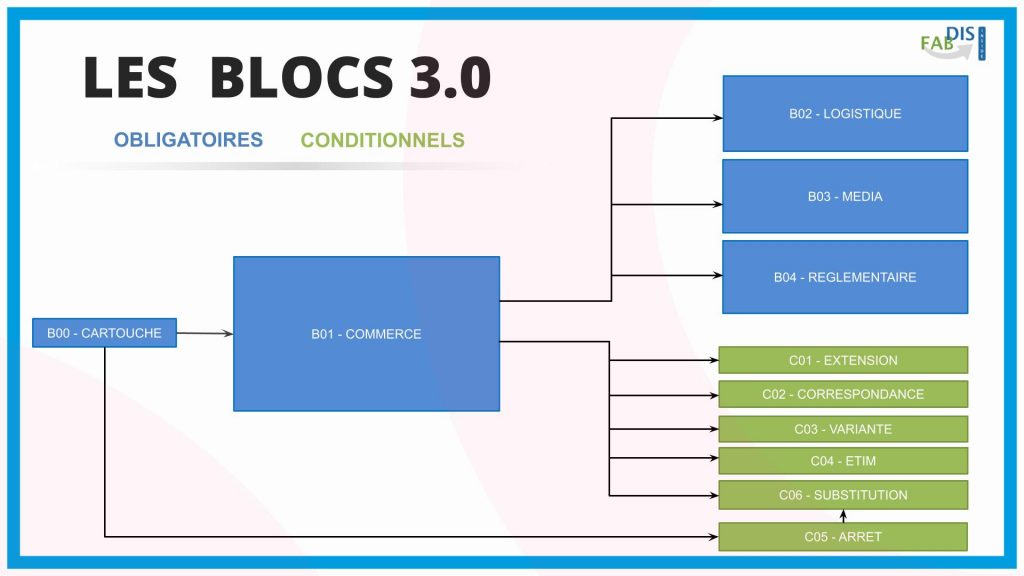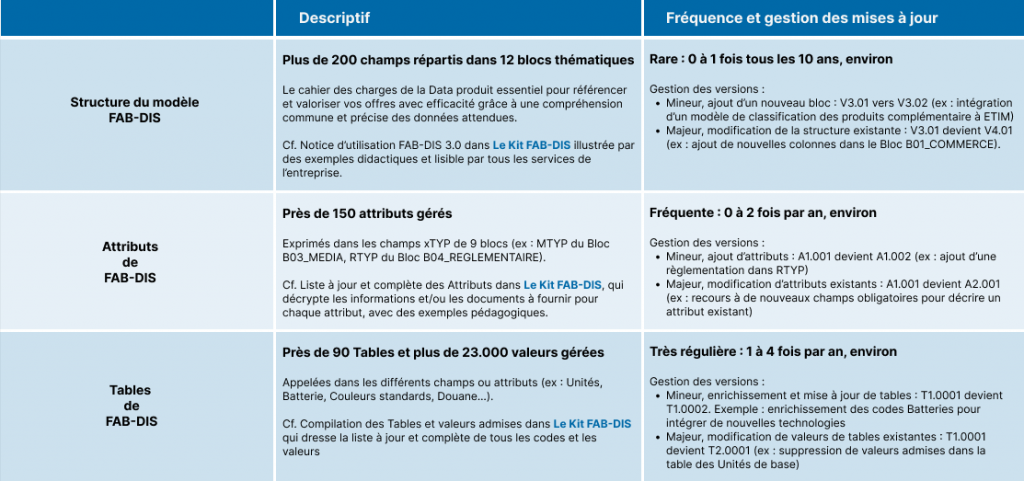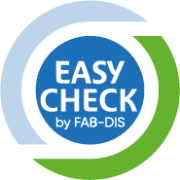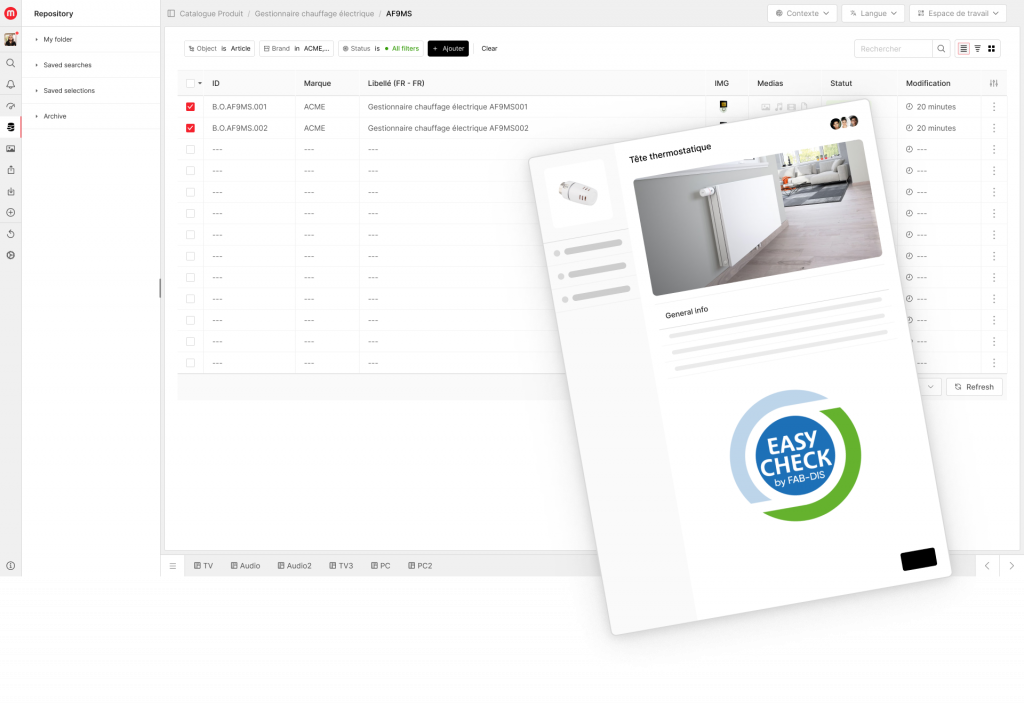Created in 2015, the FABDIS format is now the standard for exchanging product data in the building, industry and infrastructure sectors. But how can you simplify and accelerate the adaptation of your data in this format? This article explores best practices for creating compliant files with Easy-Check by FABDIS certification, and the importance of FABDIS Inside certification.
Find out how to maximize the efficiency of your product data management with the FABDIS format.
1. What is the FABDIS format and why choose it?
This standardized file format has been designed to facilitate the sharing of product information between manufacturers and distributors. Particularly in the electrical and building sectors. Developed by key players in this sector, it meets three key challenges:
- Reliability of exchanges: guarantee the transmission of comprehensive, high-quality and well-organized product data between different business partners, such as manufacturers and distributors.
- Reduced time-to-market: thanks to this standardized format, products can be integrated more quickly into distributors’ catalogs. A time saving estimated at 40% according to FABDIS.
- Regulatory compliance: FABDIS makes it easier to bring products to market. For example, by integrating ever-changing legal and normative requirements.
A template based on the Excel file format (XLSX)
The model is based on a file in Excel format (XLSX), structured into blocks containing the data essential to product marketing:
- General product information: item code, label, short and long description.
- Technical specifications: dimensions, weight, materials.
- Pricing: unit prices, discounts, commercial conditions.
- Standards and certifications: compliance with regulations, CE markings, technical data sheets.
- Visuals and media: photos, videos, notices in digital format.
Adopted by over 1,200 companies, including leaders such as :
Delta Dore, Rexel, Acova, Leroy Merlin,Saint-Gobain, Pompac, Rexel, Sonepar, Algorel, SOCODA, Richardson, UGD, BigMat, L’Entrepôt du Bricolage, Legrand, Schneider Electric, Groupe Atlantic, GEBERIT, Soprema and Hager.
FABDIS has become an essential standard for making product data exchange more reliable and simpler.
In 2023, FABDIS continues to adapt to market demands and is upgrading its format to version 3.0. In this way, it consolidates its position as a reference for the entire building industry. This evolution facilitates the maintenance of the format, and enables seamless integration with modern systems. These include PIM (Product Information Management), ERP and eCommerce platforms.
Discover how Nicoll Groupe Aliaxis benefits from the FABDIS format – Replay Webinar
2. FABDIS 3.0 file structure: Everything you need to know
FABDIS 3.0 format is organized into modular blocks, enabling detailed and flexible management of product data. These blocks can be mandatory or conditional, depending on the information to be shared. Here’s how these blocks are organized to meet the needs of manufacturers and distributors.
Mandatory blocks
B01 – Commerce
This block lists commercialized references (items or services), with information such as base units, labels, and product life cycle. It can be used to manage the transition to discontinued or substitute products.
B00 – Cartridge
This block defines the sender, marks and parameters of referencing data (output type, date, currency, etc.).
B02 – Logistics
This block contains detailed logistics data, including dimensions, weights and multiple packaging.
B03 – Media
This block promotes products through marketing materials (photos, videos, product sheets). It allows you to assign a specific language or target to each medium.
B04 – Regulatory
It highlights product compliance with current regulations. For example, eco-contributions, reparability index and carbon footprint.
Conditional blocks
C01 – Extension
This block extends the information contained in the Commerce and Logistics blocks. It adds specific features such as “Made In”, government aid and multiple guarantees.
C02 – Correspondence
Allows you to link a reference to others to enhance your product range. For example, spare parts, consumables or complementary products.
C03 – Variant
This block facilitates product selection according to predefined variation criteria, such as size, color or material.
C04 – ETIM
It shares the technical characteristics of the ETIM standard. Now integrated in its most recent version (ETIM 9.0).
C05 – Stop
This block compiles withdrawn part numbers and provides information on their availability. Also for leaflets and spare parts.
C06 – Substitution
It identifies the most appropriate replacement product when a product is withdrawn or undergoing maintenance.
2.1 FABDIS 3.0 – A scalable, flexible structure
The FABDIS 3.0 format is designed to be durable yet flexible. It makes it easy to integrate new requirements, such as adding attributes or values to blocks. All without disrupting the existing structure.
This agility guarantees smooth evolution while preserving the stability of the format for its users. As a result, they avoid any impact on their business.

3. Why create my files with a FABDIS Inside-certified solution?
By opting for a solution validated by the FABDIS Insidepartnership, such as MaPS System. You are choosing a platform that is compliant, intuitive and perfectly adapted to the requirements of the FABDIS 3.0 model.
This partnership guarantees several strategic advantages for your company. By facilitating the management of your product files and optimizing exchanges with your commercial partners:
Data compliance and security : MaPS System’s data quality management features ensure that your files comply with the FABDIS 3.0 model. This eliminates frequent errors and ensures reliable data exchange.
Simplicity and fluidity of processes : Centralize your product data on a single reference platform. This simplifies catalog export and validation via Easy-Check by FABDIS, with no development required.
Fast, automated validation: Thanks to integration with Easy-Check by FABDIS, file validation is instantaneous. You receive a unique compliance number, certifying the conformity of your data.
Personalized support and ongoing updates : The FABDIS Inside partnership ensures expert support. He or she will keep you informed of model developments and provide ongoing expertise.
Improved data quality: Thanks to MaPS System’s built-in controls, anomalies are detected and corrected directly within the source data, guaranteeing optimized files ready for compliant validation.
What’s more, by choosing MaPS System’s support, you benefit from a platform that enables you to adapt to FABDIS format updates without impacting your processes, thus guaranteeing ongoing compliance with the latest model evolutions.

Finally, with FABDIS Inside, you benefit not only from guaranteed compliance with FABDIS model standards, but also from a reliable, high-performance solution designed to facilitate your product data exchanges, while improving the efficiency, quality and security of your processes.
Discover our FABDIS Inside certified solution4. Common mistakes to avoid
Aside from its many advantages, adopting the FABDIS format can present certain challenges. Here are some common mistakes to avoid if you want to ensure efficient management of your product files:
- Poor data structuring : Failure to respect the standardized structure of the FABDIS format can lead to import errors or incompatibilities with partner systems. It is crucial to follow the format specifications carefully to avoid these problems.
For example: forgetting certain logistical data, such as the dimensions or weight of a product, will not necessarily block the marketing of products. E n consequence, this can lead to poor inventory management or product presentation at the distributor’s premises. - Failure to validate data: Failure to check data for conformity before sending it can lead to errors. Such as missing or incorrect information. Using a tool like MaPS System allows you to validate files before distribution.
For example: A product description that exceeds the length allowed by FABDIS may cause the import to be rejected. - Forget metadata: Information such as units of measurement, category codes, or links to product images are essential to ensure data consistency. Omitting these elements can lead to misunderstandings and harm the quality of commercial exchanges.
For example: Not including a link to a product image prevents it from being displayed on distributors’ eCommerce sites. - Ignore updates: FABDIS files need to be regularly updated to reflect product developments (prices, new references, promotions). Not keeping your files up to date can lead to inconsistencies and delays.
For example: Failure to include a new product reference in an update may result in delayed availability in the distribution network.
Firstly, it should be noted that all these errors can be easily avoided by relying on adapted tools that help you maintain the necessary rigor in the management of your product data. Secondly, the implementation of control processes, such as those proposed by MaPS System, enables you to guarantee optimum compliance and anticipate errors.
5. How does Easycheck ensure the conformity of my files?

Easy-Check by FABDIS is a control tool that improves the quality of your FABDIS files. It automatically detects any anomalies in your files that may delay validation, and therefore the marketing of your products. The tool provides detailed reports to help you, and guides you in correcting errors.
With Easy-Check, you also get KPIs that enable you to prioritize the efforts needed to improve the quality of your files.
Although this process is independent of MaPS System, even before generating your FABDIS files and submitting them to Easy-Check, the platform performs quality checks via its DQM (Data Quality Management) module, and verifies that all your data is complete and consistent in order to meet Easy-Check’s requirements.
Once this step has been validated, you can create the FABDIS 3.0 file using MaPS System’s Data Export tool, then submit your file to Easy-Check to finalize validation.
Please note: This feature requires a subscription to Easy-Check PREMIUM. However, this step is not mandatory to generate and use your files. To find out more, visit the Easy-Check platform.
The benefits for your company :
- Simplified syndication: Data is automatically homogenized and ready to share with your distribution partners, eliminating the need to go back and forth on the file.
- Data reliability: Thanks to quality control of your data prior to file creation, you can be sure that your product information is complete and ready for validation.
- Time-saving: MaPS System’s automated export function makes export management quick and easy, while giving you total autonomy in the creation and maintenance of your FABDIS files.

Adopting the FABDIS format is an undeniable advantage.
In conclusion, FABDIS is the essential format for simplifying and accelerating the exchange of product data between manufacturers and distributors. By adopting this model, and leveraging complementary tools such as a PIM solution, you benefit from a standardized structure that reduces errors, improves information quality and optimizes the time it takes to get your products to market.
Nevertheless, to guarantee the conformity of your files and maximize the benefits of using the FABDIS format, it’s important to be able to rely on a FABDIS Inside certified solution. These solutions make it easier to take advantage of FABDIS services such as Easy-Check.


